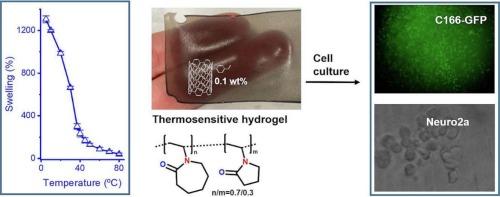Thermosensitive hydrogels based on Poly(VCL-co-VP) loaded with carbon nanotubes for cell culture: role of the functionalization on the neural cell growth
IF 6.3
2区 化学
Q1 POLYMER SCIENCE
引用次数: 0
Abstract
In this study, thermosensitive hydrogels based on vinyl-lactams, loaded with multi-walled carbon nanotubes (MWCNTs, hereinafter CNTs) in a range of weight percentages up to 0.3 %, have been prepared. To optimize charge dispersion in the polymeric network matrix, CNTs have been functionalized on the one hand to facilitate dispersion in the precursor formulation, and precursor formulations containing different percentages of two types of vinyl-lactams, vinylcaprolactam (VCL) and vinylpyrrolidone (VP), have been evaluated on the other. The incorporation of functionalized CNTs increased the compressive modulus of the hydrogels more than sixfold (from ∼ 0.6 to ∼ 3.7 MPa) and improved electrical conductivity by an order of magnitude (from 8.6·10−3 to 8.1·10−2 S·m−1), while promoting higher rates of adhesion and proliferation of endothelial and neuronal cells. These improvements highlight the potential of the developed system for biomedical applications, such as tissue engineering and regenerative medicine.

负载碳纳米管的聚(VCL-co-VP)热敏水凝胶的细胞培养:功能化对神经细胞生长的作用
在本研究中,制备了基于乙烯内酰胺的热敏水凝胶,负载了重量百分比在0.3%范围内的多壁碳纳米管(MWCNTs,以下简称CNTs)。为了优化电荷在聚合物网络基质中的分散,一方面对碳纳米管进行了功能化以促进前驱体配方中的分散,另一方面对含有不同百分比的乙烯基内酰胺(VCL)和乙烯基吡啶酮(VP)的前驱体配方进行了评价。功能化CNTs的掺入使水凝胶的压缩模量增加了6倍以上(从~ 0.6到~ 3.7 MPa),电导率提高了一个数量级(从8.6·10−3到8.1·10−2 S·m−1),同时促进了内皮细胞和神经元细胞的更高粘附率和增殖率。这些改进突出了开发的系统在生物医学应用方面的潜力,例如组织工程和再生医学。
本文章由计算机程序翻译,如有差异,请以英文原文为准。
求助全文
约1分钟内获得全文
求助全文
来源期刊

European Polymer Journal
化学-高分子科学
CiteScore
9.90
自引率
10.00%
发文量
691
审稿时长
23 days
期刊介绍:
European Polymer Journal is dedicated to publishing work on fundamental and applied polymer chemistry and macromolecular materials. The journal covers all aspects of polymer synthesis, including polymerization mechanisms and chemical functional transformations, with a focus on novel polymers and the relationships between molecular structure and polymer properties. In addition, we welcome submissions on bio-based or renewable polymers, stimuli-responsive systems and polymer bio-hybrids. European Polymer Journal also publishes research on the biomedical application of polymers, including drug delivery and regenerative medicine. The main scope is covered but not limited to the following core research areas:
Polymer synthesis and functionalization
• Novel synthetic routes for polymerization, functional modification, controlled/living polymerization and precision polymers.
Stimuli-responsive polymers
• Including shape memory and self-healing polymers.
Supramolecular polymers and self-assembly
• Molecular recognition and higher order polymer structures.
Renewable and sustainable polymers
• Bio-based, biodegradable and anti-microbial polymers and polymeric bio-nanocomposites.
Polymers at interfaces and surfaces
• Chemistry and engineering of surfaces with biological relevance, including patterning, antifouling polymers and polymers for membrane applications.
Biomedical applications and nanomedicine
• Polymers for regenerative medicine, drug delivery molecular release and gene therapy
The scope of European Polymer Journal no longer includes Polymer Physics.
 求助内容:
求助内容: 应助结果提醒方式:
应助结果提醒方式:


